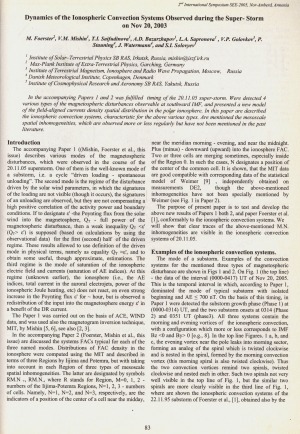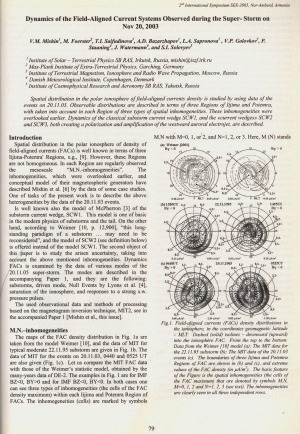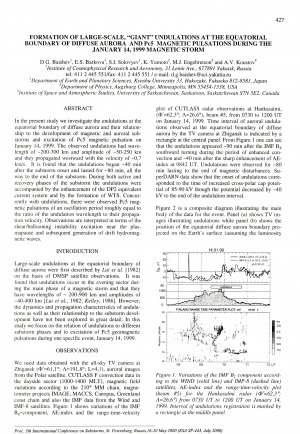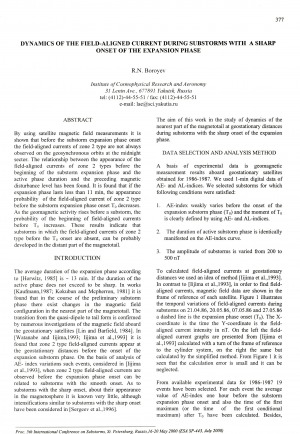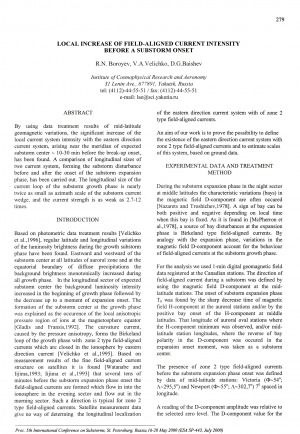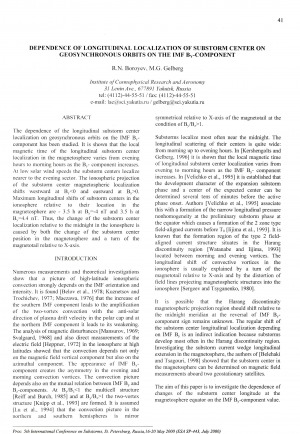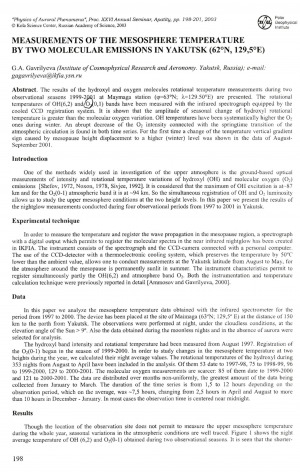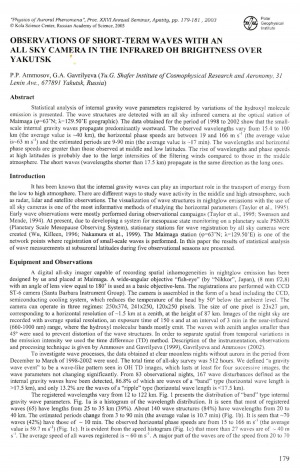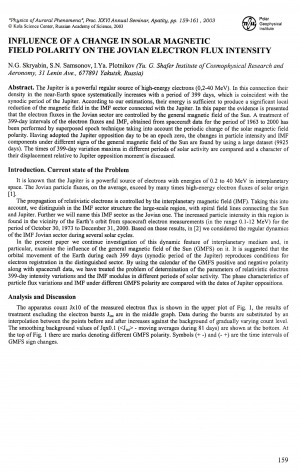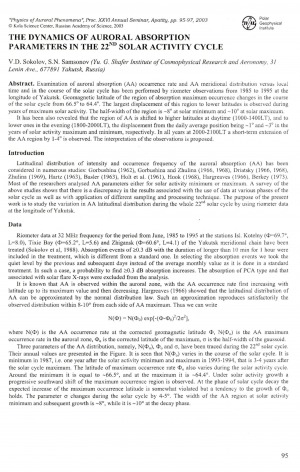Образован в 1962 г. распоряжением Совета Министров РСФСР N 3807-р об организации на базе Якутской геофизической обсерватории ЯФ СО АН СССР самостоятельного академического учреждения - Института космофизических исследований и аэрономии СО АН СССР. В 2003 г. постановлением Президиума РАН присвоено имя его основателя профессора Ю. Г. Шафера.
Количество страниц: 3 с.
- Математика. Естественные науки > Астрономия. Астрофизика. Исследование космического пространства. Геодезия,
- Математика. Естественные науки > Геология. Геологические и геофизические науки,
- Прикладные науки. Медицина. Ветеринария. Техника. Сельское хозяйство > Инженерное дело. Техника в целом,
- НАУКА ЯКУТИИ > МАТЕМАТИКА. ЕСТЕСТВЕННЫЕ НАУКИ > Астрономия. Астрофизика. Исследование космического пространства. Геодезия,
- НАУКА ЯКУТИИ > ПРИКЛАДНЫЕ НАУКИ. МЕДИЦИНА. ТЕХНИКА. СЕЛЬСКОЕ ХОЗЯЙСТВО > Инженерное дело. Техника в целом,
- НАУКА ЯКУТИИ > МАТЕМАТИКА. ЕСТЕСТВЕННЫЕ НАУКИ > Геология. Геологические и геофизические науки.
Dynamics of the Ionospheric Convection Systems Observed during The Super-Storm on Nov. 20, 2003 / M. Foerster, V. M. Mishin, T. I. Saifudinova, A. D. Bazarzhapov, L. A. Sapronova, V. P. Golovkov, P. Stauning, J. Watermann, and S. I. Solovyev // Solar Extreme Events Fundamental Science and Applied Aspects Nor-Amberd, Armenia 26-30 September 2005 : proceedings of the Second International Symposium / edited by A. Chilingarian and G. Karapetyan. − Erevan : Cosmic Ray Division, Alikhanyan Physics Institute, 2006. − P. 83-85.
Количество страниц: 4 с.
Dynamics of the Field-Aligned Current Systems Observed during The Super-Storm on Nov. 20, 2003 / V. M. Mishin, M. Foerster, T. I. Saifudinova, A. D. Bazarzhapov, L. A. Sapronova, V. P. Golovkov, P. Stauning, J. Watermann, and S. I. Solovyev // Solar Extreme Events Fundamental Science and Applied Aspects Nor-Amberd, Armenia 26-30 September 2005 : proceedings of the Second International Symposium / edited by A. Chilingarian and G. Karapetyan. − Erevan : Cosmic Ray Division, Alikhanyan Physics Institute, 2006. − P. 79-82.
Количество страниц: 4 с.
Formation of large-scale, "giant" undulations at the equatorial boundary of diffuse aurora and Pc5 magnetic pulsations during the January 14, 1999 magnetic storm / D. G. Baishev, E. S. Barkova, S. I. Solovyev, K. Yumoto, M. J. Engebretson and A. V. Koustov // Proceedings of the Fifth International Conference on Substorms : 16-20 May 2000 Congress Centre of the Arctic and Antarctic Research Institute, St. Petersburg, Russia. − Noordwijk, Netherlands : European Space Agency, 2000. − P. 427-430.
Количество страниц: 4 с.
Boroyev, R. N. Dynamics of the field-aligned current during substorms with a sharp onset of the expansion phase / R. N. Boroyev // Proceedings of the Fifth International Conference on Substorms : 16-20 May 2000 Congress Centre of the Arctic and Antarctic Research Institute, St. Petersburg, Russia. − Noordwijk, Netherlands : European Space Agency, 2000. − P. 377-380.
Количество страниц: 4 с.
Boroyev, R. N. Local increase of field-aligned current intensity before a substorm onset / R. N. Boroyev, V. A. Velichko, D. G. Baishev // Proceedings of the Fifth International Conference on Substorms : 16-20 May 2000 Congress Centre of the Arctic and Antarctic Research Institute, St. Petersburg, Russia. − Noordwijk, Netherlands : European Space Agency, 2000. − P. 279-282.
Количество страниц: 4 с.
Boroyev, R. N. Dependence of longitudinal localization of substorm center on geosynchronous orbits on the IMF Bγ-component / R. N. Boroyev, M. G. Gelberg // Proceedings of the Fifth International Conference on Substorms : 16-20 May 2000 Congress Centre of the Arctic and Antarctic Research Institute, St. Petersburg, Russia. − Noordwijk, Netherlands : European Space Agency, 2000. − P. 41-44.
Количество страниц: 4 с.
Gavrilyeva, G. A. Measurements of the mesosphere temperature by two molecular emissions in Yakutsk (62°N, 129,5°E) / G. A. Gavrilyeva // Physics of auroral phenomena : proceedings of the 26th annual seminar, 25 - 28 February 2003. – 2003. – P. 198-201.
Количество страниц: 3 с.
Ammosov, P. P. Observations of short-term waves with an all sky camera in the infrared oh brightness over Yakutsk / P. P. Ammosov, G. A. Gavrilyeva // Physics of auroral phenomena : proceedings of the 26th annual seminar, 25 -28 February 2003. – 2003. – P. 179-181.
Количество страниц: 3 с.
Skryabin, N. G. Influence of a change in solar magnetic field polarity on the Jovian electron flux intensity / N. G. Skryabin, S. N. Samsonov, I. Ya. Plotnikov // Physics of auroral phenomena : proceedings of the 26th annual seminar, 25 - 28 February 2003. – 2003. – P. 159-161.
Количество страниц: 3 с.
Sokolov, V. D. The dynamics of auroral absorption parameters in the 22nd solar activity cycle / V. D. Sokolov, S. N. Samsonov // Physics of auroral phenomena : proceedings of the 26th annual seminar, 25 - 28 February 2003. – 2003. – P. 95-97.
